brake CITROEN C3 2023 Owners Manual
[x] Cancel search | Manufacturer: CITROEN, Model Year: 2023, Model line: C3, Model: CITROEN C3 2023Pages: 104, PDF Size: 2.38 MB
Page 5 of 104
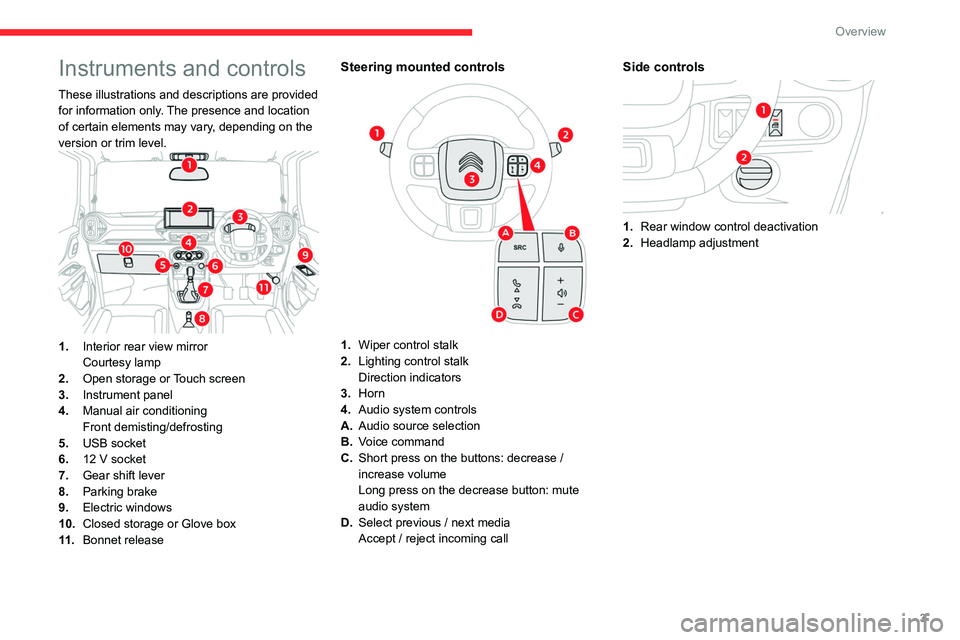
3
Overview
Instruments and controls
These illustrations and descriptions are provided
for information only. The presence and location
of certain elements may vary, depending on the
version or trim level.
1.Interior rear view mirror
Courtesy lamp
2. Open storage or Touch screen
3. Instrument panel
4. Manual air conditioning
Front demisting/defrosting
5. USB socket
6. 12 V socket
7. Gear shift lever
8. Parking brake
9. Electric windows
10. Closed storage or Glove box
11 . Bonnet release
Steering mounted controls
1.Wiper control stalk
2. Lighting control stalk
Direction indicators
3. Horn
4. Audio system controls
A. Audio source selection
B. Voice command
C. Short press on the buttons: decrease
/
increase volume
Long press on the decrease button: mute
audio system
D. Select previous
/ next media
Accept
/ reject incoming call
Side controls
1.Rear window control deactivation
2. Headlamp adjustment
Page 6 of 104
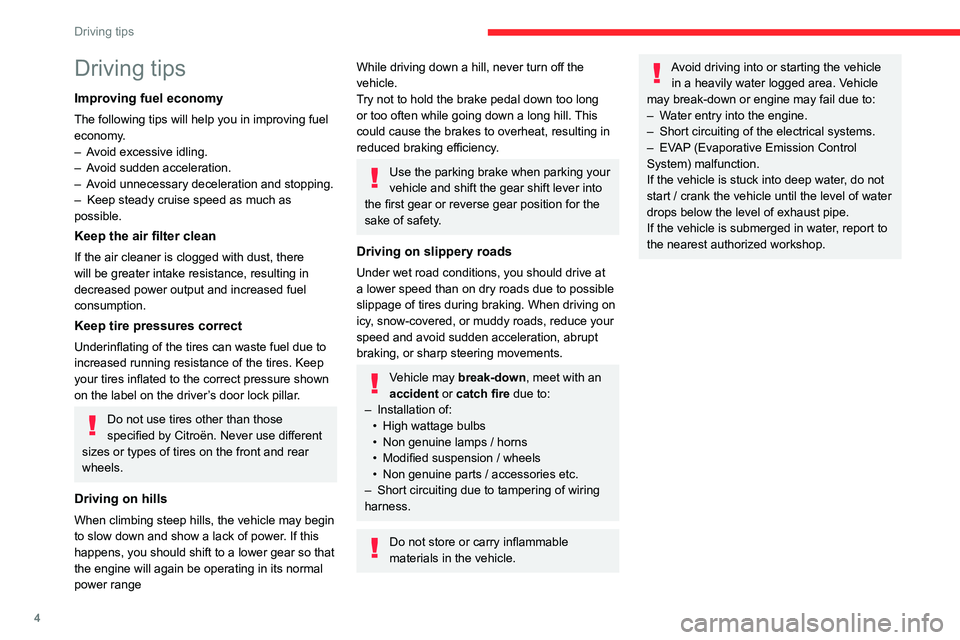
4
Driving tips
Driving tips
Improving fuel economy
The following tips will help you in improving fuel
economy.
–
A
void excessive idling.
–
A
void sudden acceleration.
–
A
void unnecessary deceleration and stopping.
–
Keep steady cruise speed as much as
possible.
Keep the air filter clean
If the air cleaner is clogged with dust, there
will be greater intake resistance, resulting in
decreased power output and increased fuel
consumption.
Keep tire pressures correct
Underinflating of the tires can waste fuel due to
increased running resistance of the tires. Keep
your tires inflated to the correct pressure shown
on the label on the driver’s door lock pillar.
Do not use tires other than those
specified by Citroën. Never use different
sizes or types of tires on the front and rear
wheels.
Driving on hills
When climbing steep hills, the vehicle may begin
to slow down and show a lack of power. If this
happens, you should shift to a lower gear so that
the engine will again be operating in its normal
power range
While driving down a hill, never turn off the
vehicle.
Try not to hold the brake pedal down too long
or too often while going down a long hill. This
could cause the brakes to overheat, resulting in
reduced braking efficiency.
Use the parking brake when parking your
vehicle and shift the gear shift lever into
the first gear or reverse gear position for the
sake of safety.
Driving on slippery roads
Under wet road conditions, you should drive at
a lower speed than on dry roads due to possible
slippage of tires during braking. When driving on
icy, snow-covered, or muddy roads, reduce your
speed and avoid sudden acceleration, abrupt
braking, or sharp steering movements.
Vehicle may break-down, meet with an
accident or catch fire due to:
–
Installation of:
•
High wattage bulbs
•
Non genuine lamps / horns
•
Modified suspension / wheels
•
Non genuine parts / accessories etc.
–
Short circuiting due to tampering of wiring
harness.
Do not store or carry inflammable
materials in the vehicle.
Avoid driving into or starting the vehicle in a heavily water logged area. Vehicle
may break-down or engine may fail due to:
–
W
ater entry into the engine.
–
Short circuiting of the electrical systems.
–
EV
AP (Evaporative Emission Control
System) malfunction.
If the vehicle is stuck into deep water, do not
start / crank the vehicle until the level of water
drops below the level of exhaust pipe.
If the vehicle is submerged in water, report to
the nearest authorized workshop.
Page 8 of 104
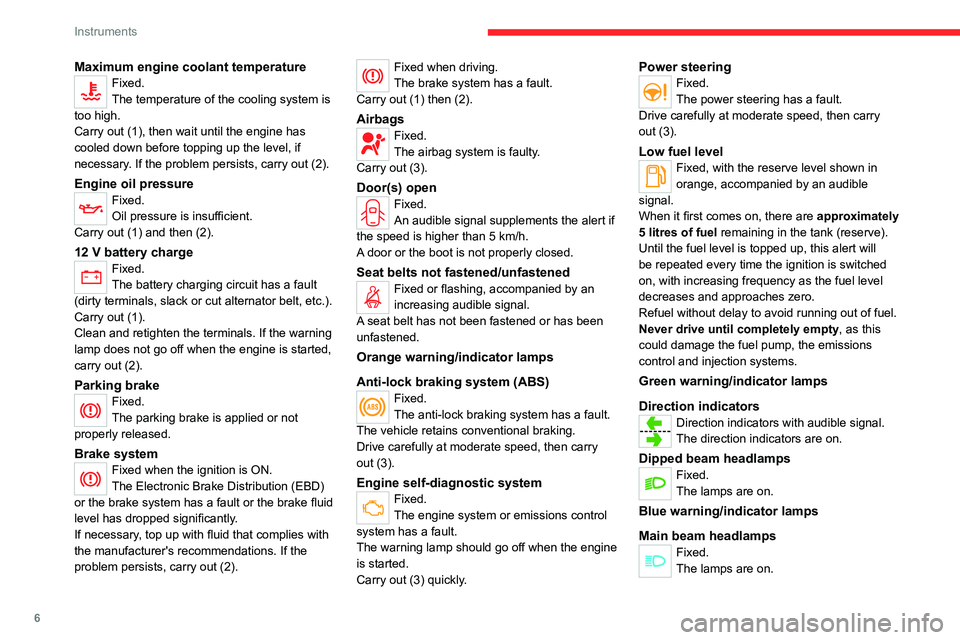
6
Instruments
Maximum engine coolant temperatureFixed.
The temperature of the cooling system is
too high.
Carry out (1), then wait until the engine has
cooled down before topping up the level, if
necessary. If the problem persists, carry out (2).
Engine oil pressureFixed.
Oil pressure is insufficient.
Carry out (1) and then (2).
12 V battery chargeFixed.
The battery charging circuit has a fault
(dirty terminals, slack or cut alternator belt, etc.).
Carry out (1).
Clean and retighten the terminals. If the warning
lamp does not go off when the engine is started,
carry out (2).
Parking brakeFixed.
The parking brake is applied or not
properly released.
Brake systemFixed when the ignition is ON.
The Electronic Brake Distribution (EBD)
or the brake system has a fault or the brake fluid
level has dropped significantly.
If necessary, top up with fluid that complies with
the manufacturer's recommendations. If the
problem persists, carry out (2).
Fixed when driving.
The brake system has a fault.
Carry out (1) then (2).
AirbagsFixed.
The airbag system is faulty.
Carry out (3).
Door(s) openFixed.
An audible signal supplements the alert if
the speed is higher than 5
km/h.
A door or the boot is not properly closed.
Seat belts not fastened/unfastenedFixed or flashing, accompanied by an
increasing audible signal.
A seat belt has not been fastened or has been
unfastened.
Orange warning/indicator lamps
Anti-lock braking system (ABS)
Fixed.
The anti-lock braking system has a fault.
The vehicle retains conventional braking.
Drive carefully at moderate speed, then carry
out (3).
Engine self-diagnostic systemFixed.
The engine system or emissions control
system has a fault.
The warning lamp should go off when the engine
is started.
Carry out (3) quickly.
Power steeringFixed.
The power steering has a fault.
Drive carefully at moderate speed, then carry
out (3).
Low fuel levelFixed, with the reserve level shown in
orange, accompanied by an audible
signal.
When it first comes on, there are
approximately
5 litres of fuel remaining in the tank (reserve).
Until the fuel level is topped up, this alert will
be repeated every time the ignition is switched
on, with increasing frequency as the fuel level
decreases and approaches zero.
Refuel without delay to avoid running out of fuel.
Never drive until completely empty, as this
could damage the fuel pump, the emissions
control and injection systems.
Green warning/indicator lamps
Direction indicators
Direction indicators with audible signal.
The direction indicators are on.
Dipped beam headlampsFixed.
The lamps are on.
Blue warning/indicator lamps
Main beam headlamps
Fixed.
The lamps are on.
Page 25 of 104
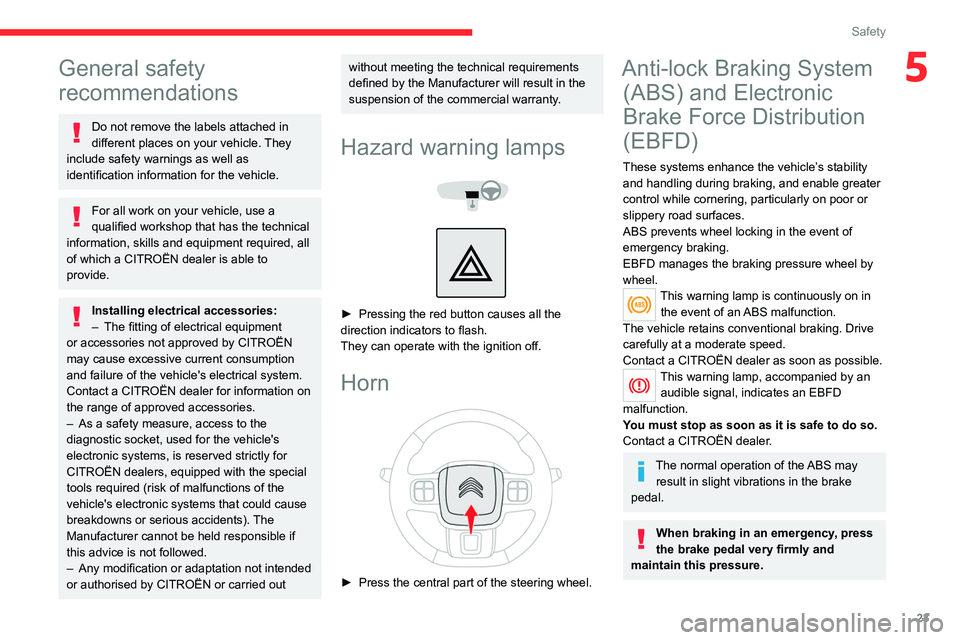
23
Safety
5General safety
recommendations
Do not remove the labels attached in
different places on your vehicle. They
include safety warnings as well as
identification information for the vehicle.
For all work on your vehicle, use a
qualified workshop that has the technical
information, skills and equipment required, all
of which a CITROËN dealer is able to
provide.
Installing electrical accessories:
– The fitting of electrical equipment
or accessories not approved by CITROËN
may cause excessive current consumption
and failure of the vehicle's electrical system.
Contact a CITROËN dealer for information on
the range of approved accessories.
–
As a safety measure, access to the
diagnostic socket, used for the vehicle's
electronic systems, is reserved strictly for
CITROËN dealers, equipped with the special
tools required (risk of malfunctions of the
vehicle's electronic systems that could cause
breakdowns or serious accidents).
The
Manufacturer cannot be held responsible if
this advice is not followed.
–
Any modification or adaptation not intended
or authorised by CITROËN or carried out
without meeting the technical requirements
defined by the Manufacturer will result in the
suspension of the commercial warranty.
Hazard warning lamps
► Pressing the red button causes all the
direction indicators to flash.
They can operate with the ignition off.
Horn
► Press the central part of the steering wheel.
Anti-lock Braking System (ABS) and Electronic
Brake Force Distribution
(EBFD)
These systems enhance the vehicle’s stability
and handling during braking, and enable greater
control while cornering, particularly on poor or
slippery road surfaces.
ABS prevents wheel locking in the event of
emergency braking.
EBFD manages the braking pressure wheel by
wheel.
This warning lamp is continuously on in
the event of an ABS malfunction.
The vehicle retains conventional braking. Drive
carefully at a moderate speed.
Contact a CITROËN dealer as soon as possible.
This warning lamp, accompanied by an audible signal, indicates an EBFD
malfunction.
You must stop as soon as it is safe to do so.
Contact a CITROËN dealer.
The normal operation of the ABS may result in slight vibrations in the brake
pedal.
When braking in an emergency, press
the brake pedal very firmly and
maintain this pressure.
Page 33 of 104

31
Driving
6Driving recommendations
► Observe the driving regulations and remain
vigilant whatever the traffic conditions.
►
Monitor your environment and keep your
hands on the wheel to be able to react to
anything that may happen any time.
►
Drive smoothly
, anticipate the need for
braking and maintain a longer safety distance,
especially in bad weather.
►
Stop the vehicle to carry out operations that
require close attention (such as adjustments).
►
During long trips, take a break every two
hours.
Important!
Never leave the engine running in a
closed space without sufficient
ventilation. Internal combustion engines emit
toxic exhaust gases such as carbon
monoxide. Danger of poisoning and death!
In severe wintry conditions, let the engine
run for 4 minutes before moving off, to
ensure the correct operation and durability of
the mechanical components of your vehicle
(engine and gearbox).
Never drive with the parking brake
applied . Risk of overheating and
damage to the braking system!
Do not park the vehicle or leave the
engine running on a flammable
surface (dry grass, dead leaves, etc.). The
exhaust system of your vehicle is very hot,
even several minutes after the engine stops.
Risk of fire!
Never leave a vehicle unattended with
the engine running. If you have to leave
your vehicle with the engine running, apply
the parking brake and put the gearbox into
neutral.
Never leave children inside the vehicle
unsupervised.
On flooded roads
We strongly advise against driving on flooded
roads, as this could cause serious damage to
the engine or gearbox, as well as to the electrical
systems of your vehicle.
If you have to drive on a flooded road:
► drive as slowly as possible without stalling. In
all cases, do not exceed 10
km/h,►
do not stop and do not switch off the engine.
On leaving the flooded road, as soon as safety
conditions allow
, make several light brake
applications to dry the brake discs and pads.
If in doubt about the state of your vehicle,
contact a CITROËN dealer.
Starting / Switching off the
engine
Key ignition switch
It has 4 positions:
1. Stop Inserting and removing the key, steering
column locked.
2. ACC Steering column unlocked, use of the
vehicle's electric equipment.
3. ON (Ignition) Steering column unlocked, ignition on, engine
running.
4. Starting
Page 34 of 104

32
Driving
Avoid attaching heavy objects to the key or the remote control. It would weigh
down on its shaft in the ignition switch and
could cause a malfunction.
Ignition on position
It allows the use of the vehicle's electric
equipment or portable devices to be charged.
Starting the engine
With the parking brake applied:
► Place the gear lever in neutral then fully
depress the clutch pedal.
►
Insert the key into the ignition switch; the
system recognises the code.
►
Unlock
the steering column by simultaneously
turning the steering wheel and the key.
In certain cases, you may have to apply
significant force to move the steering
wheel (wheels on full lock, for example).
►
Operate the starter motor by turning the key
to position
3 without pressing the accelerator
pedal, until the engine starts. Once the engine
starts, release the key.
After a cold start, preheating the catalytic converter can cause noticeable engine
vibrations for anything up to 2 minutes while
stationary with the engine running
(accelerated idle speed).
If the engine does not start straight away,
switch off the ignition. Wait a few
seconds before operating the starter motor
again. If the engine does not start after a few
attempts, do not keep trying - risk of
damaging the starter motor, the battery and
the engine.
Contact a CITROËN dealer.
In mild conditions, do not leave the
engine at idle to warm up but move off
straight away and drive at moderate speed.
5-speed manual gearbox
Engaging reverse gear
► Fully depress the clutch pedal.
► Push the gear lever fully to the right, then
backwards.
Only engage reverse gear when the
vehicle is stationary with the engine at
idle.
As a safety precaution and to facilitate starting the engine:
–
Always select neutral.
–
Depress the clutch pedal.
6-speed manual gearbox
Engaging 5th or 6th gear
► Move the gear selector fully to the right to
engage 5th or 6th gear.
Failure to follow this instruction could
cause permanent damage to the gearbox
(inadvertent engagement of 3
rd or 4th gear).
Engaging reverse gear
► Raise the ring under the knob and move the
gear selector to the left, then forwards.
Page 39 of 104
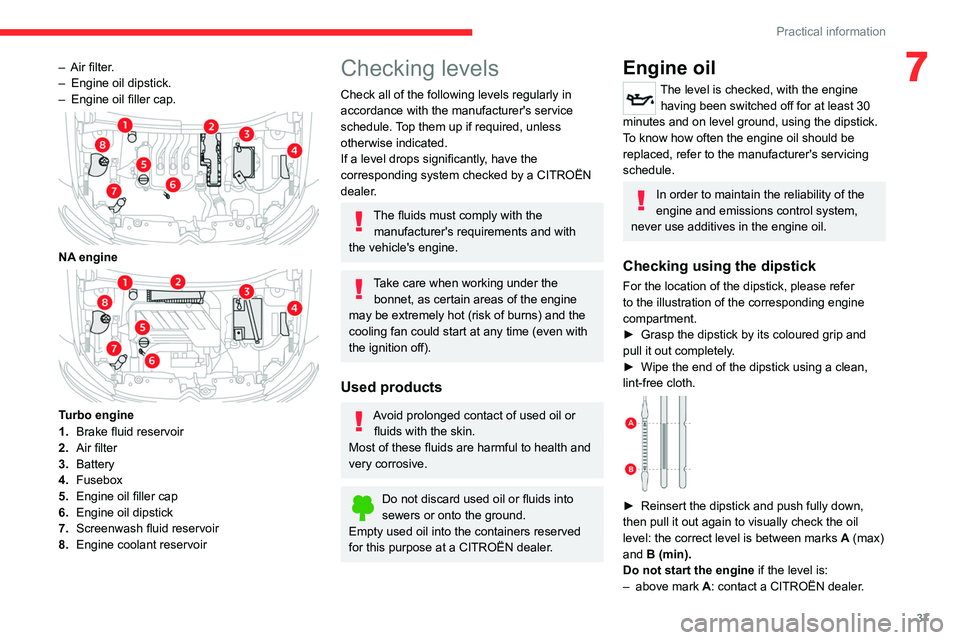
37
Practical information
7– Air filter.
– Engine oil dipstick.
–
Engine oil filler cap.
NA engine
Turbo engine
1. Brake fluid reservoir
2. Air filter
3. Battery
4. Fusebox
5. Engine oil filler cap
6. Engine oil dipstick
7. Screenwash fluid reservoir
8. Engine coolant reservoir
Checking levels
Check all of the following levels regularly in
accordance with the manufacturer's service
schedule. Top them up if required, unless
otherwise indicated.
If a level drops significantly, have the
corresponding system checked by a CITROËN
dealer.
The fluids must comply with the
manufacturer's requirements and with
the vehicle's engine.
Take care when working under the bonnet, as certain areas of the engine
may be extremely hot (risk of burns) and the
cooling fan could start at any time (even with
the ignition off).
Used products
Avoid prolonged contact of used oil or fluids with the skin.
Most of these fluids are harmful to health and
very corrosive.
Do not discard used oil or fluids into
sewers or onto the ground.
Empty used oil into the containers reserved
for this purpose at a CITROËN dealer.
Engine oil
The level is checked, with the engine having been switched off for at least 30
minutes and on level ground, using the dipstick.
To know how often the engine oil should be
replaced, refer to the manufacturer's servicing
schedule.
In order to maintain the reliability of the
engine and emissions control system,
never use additives in the engine oil.
Checking using the dipstick
For the location of the dipstick, please refer
to the illustration of the corresponding engine
compartment.
►
Grasp the dipstick by its coloured grip and
pull it out completely
.
►
Wipe the end of the dipstick using a clean,
lint-free cloth.
► Reinsert the dipstick and push fully down,
then pull it out again to visually check the oil
level: the correct level is between marks A
(max)
and B (min).
Do not start the engine if the level is:
–
above mark
A: contact a CITROËN dealer.
Page 40 of 104

38
Practical information
– below mark B : top up the engine oil
immediately.
Oil grade
Before topping up or changing the engine
oil, check that the oil is suitable for the engine
and complies with the recommendations in
the service schedule supplied with the vehicle
(or available from your CITROËN dealer).
Use of non-recommended oil may invalidate
the contractual warranty in the event of
engine failure.
Topping up the engine oil level
For the location of the engine oil filler cap, please
refer to the corresponding under-bonnet engine
compartment illustration.
►
Add oil in small quantities, avoiding any spills
on engine components (risk of fire).
►
W
ait a few minutes before checking the level
again using the dipstick.
►
T
op up the level if necessary.
►
After checking the level, carefully screw the
oil filler cap back on
and replace the dipstick in
its tube.
Within 30 minutes of adding oil, the oil
level indication in the instrument panel
when the ignition is switched on is not valid.
Brake fluid
The level of this fluid should be close to
the "MAX" mark. If not, check the leakage
in the circuit and the brake pad wear.
To know how often the brake fluid should be
replaced, refer to the manufacturer's servicing
schedule.
Clean the cap before removing it to refill.
Use only DOT3 or DOT4 brake fluid from
a sealed container.
Engine coolant
It is normal to top up this fluid between
two services.
The check and top-up must only be done with
the engine cold.
A low level presents a risk of serious damage to
the engine.
The level of engine coolant should be close to
the "MAX" mark but should never exceed it.
If the level is close to or below the " MIN” mark, it
is essential to top up.
When the engine is hot, the temperature of
engine coolant is regulated by the fan.
As the cooling system is pressurised, wait at
least one hour after switching off the engine
before carrying out any work.
In order to avoid the risk of burning, if you need
to top up in an emergency, wrap a cloth around
the cap and unscrew the cap by two turns to
allow the pressure to drop.
Once the pressure has dropped, remove the cap
and top up to the required level.
Screenwash fluid
Top up to the required level when necessary.
Fluid specification
The fluid must be topped up with a ready-to-use
mixture.
In winter (temperatures below zero), a liquid
containing an agent to prevent freezing must
be used which is appropriate for the prevailing
conditions, in order to protect the elements of the
system (pump, tank, ducts, jets, etc.).
Filling with pure water is prohibited under
all circumstances (risk of freezing,
limestone deposits, etc.).
Page 41 of 104

39
Practical information
7Consumables
DesignationGrade/Specs Quantity
Engine options EB2 - NA5W40 B712296 Synthetic 2.55 Lts
EB2 G2 Turbo 5W30 B712297 Synthetic 3.1 Lts
Transmission options Transmission fluid - MA75W - 80 B13/0067 API GL-4 2.1 ± 0.2 Lts
Transmission fluid - MB6 75W - 80 B13/0067 API GL-4 1.8 ± 0.2 Lts
HVAC Compressor Oil PS R1120 ml
AC Refrigerant for EB2 - NA R134A425 grams
AC Refrigerant for EB2 G2 Turbo R134A550 grams
Cooling Coolant (Premixed) for EB2 NA
(Antifreeze Coolant 40% + DM
/ DI
Water 60%) GOLDEN CRUISER LONG LIFE
ANTIFREEZE-COOLANT, GC LLC 2200 NP 4.65 ± 0.1 Lts
Coolant (Premixed) for EB2 G2 Turbo
(Antifreeze Coolant 40% + DM
/ DI
Water 60%) GOLDEN CRUISER LONG LIFE
ANTIFREEZE-COOLANT, GC LLC 2200 NP 5.7 ± 0.1 Lts
Brake/Clutch Brake fluidDOT3/DOT4 450 ± 50 ml
Clutch fluid Clutch fluid line connected with brake reservoir
Axle Axle oil NA
Checks
Unless otherwise indicated, check these
components in accordance with the
manufacturer's service schedule.
Otherwise, have them checked by a CITROËN
dealer.
Only use products recommended by
CITROËN.
In order to optimise the operation of
components as important as those in the
braking system, CITROËN selects and offers
very specific products.12 V battery
Check regularly during service that the
terminals and coin plug caps are clean
and tightened.
Page 42 of 104
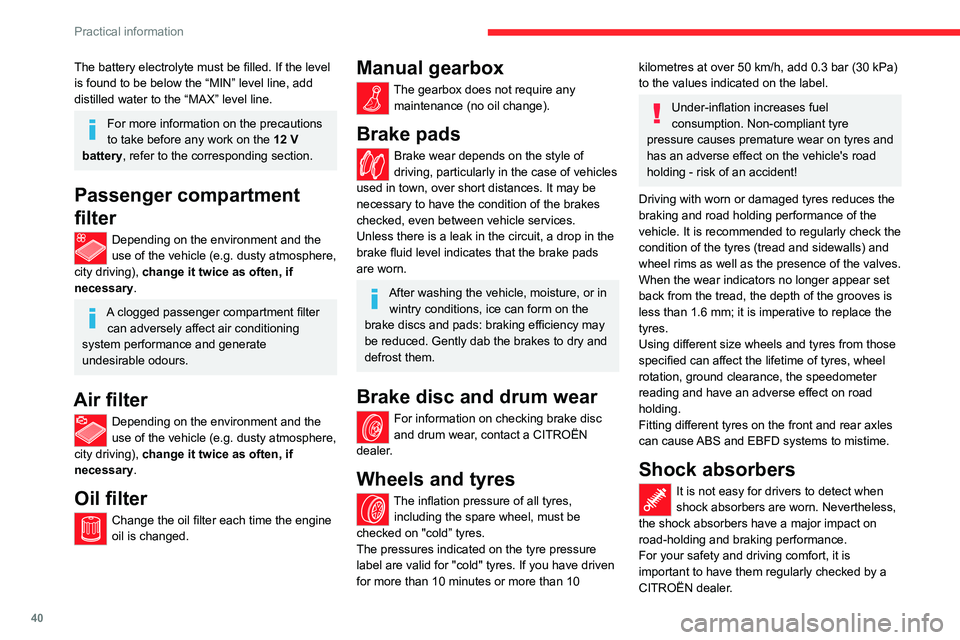
40
Practical information
The battery electrolyte must be filled. If the level
is found to be below the “MIN” level line, add
distilled water to the “MAX” level line.
For more information on the precautions
to take before any work on the 12 V
battery, refer to the corresponding section.
Passenger compartment
filter
Depending on the environment and the
use of the vehicle (e.g. dusty atmosphere,
city driving), change it twice as often, if
necessary .
A clogged passenger compartment filter
can adversely affect air conditioning
system performance and generate
undesirable odours.
Air filter
Depending on the environment and the
use of the vehicle (e.g. dusty atmosphere,
city driving), change it twice as often, if
necessary .
Oil filter
Change the oil filter each time the engine
oil is changed.
Manual gearbox
The gearbox does not require any
maintenance (no oil change).
Brake pads
Brake wear depends on the style of
driving, particularly in the case of vehicles
used in town, over short distances. It may be
necessary to have the condition of the brakes
checked, even between vehicle services.
Unless there is a leak in the circuit, a drop in the
brake fluid level indicates that the brake pads
are worn.
After washing the vehicle, moisture, or in wintry conditions, ice can form on the
brake discs and pads: braking efficiency may
be reduced. Gently dab the brakes to dry and
defrost them.
Brake disc and drum wear
For information on checking brake disc
and drum wear, contact a CITROËN
dealer.
Wheels and tyres
The inflation pressure of all tyres, including the spare wheel, must be
checked on "cold” tyres.
The pressures indicated on the tyre pressure
label are valid for "cold" tyres. If you have driven
for more than 10 minutes or more than 10
kilometres at over 50 km/h, add 0.3 bar (30 kPa)
to the values indicated on the label.
Under-inflation increases fuel
consumption. Non-compliant tyre
pressure causes premature wear on tyres and
has an adverse effect on the vehicle's road
holding - risk of an accident!
Driving with worn or damaged tyres reduces the
braking and road holding performance of the
vehicle. It is recommended to regularly check the
condition of the tyres (tread and sidewalls) and
wheel rims as well as the presence of the valves.
When the wear indicators no longer appear set
back from the tread, the depth of the grooves is
less than 1.6 mm; it is imperative to replace the
tyres.
Using different size wheels and tyres from those
specified can affect the lifetime of tyres, wheel
rotation, ground clearance, the speedometer
reading and have an adverse effect on road
holding.
Fitting different tyres on the front and rear axles
can cause ABS and EBFD systems to mistime.
Shock absorbers
It is not easy for drivers to detect when
shock absorbers are worn. Nevertheless,
the shock absorbers have a major impact on
road-holding and braking performance.
For your safety and driving comfort, it is
important to have them regularly checked by a
CITROËN dealer.